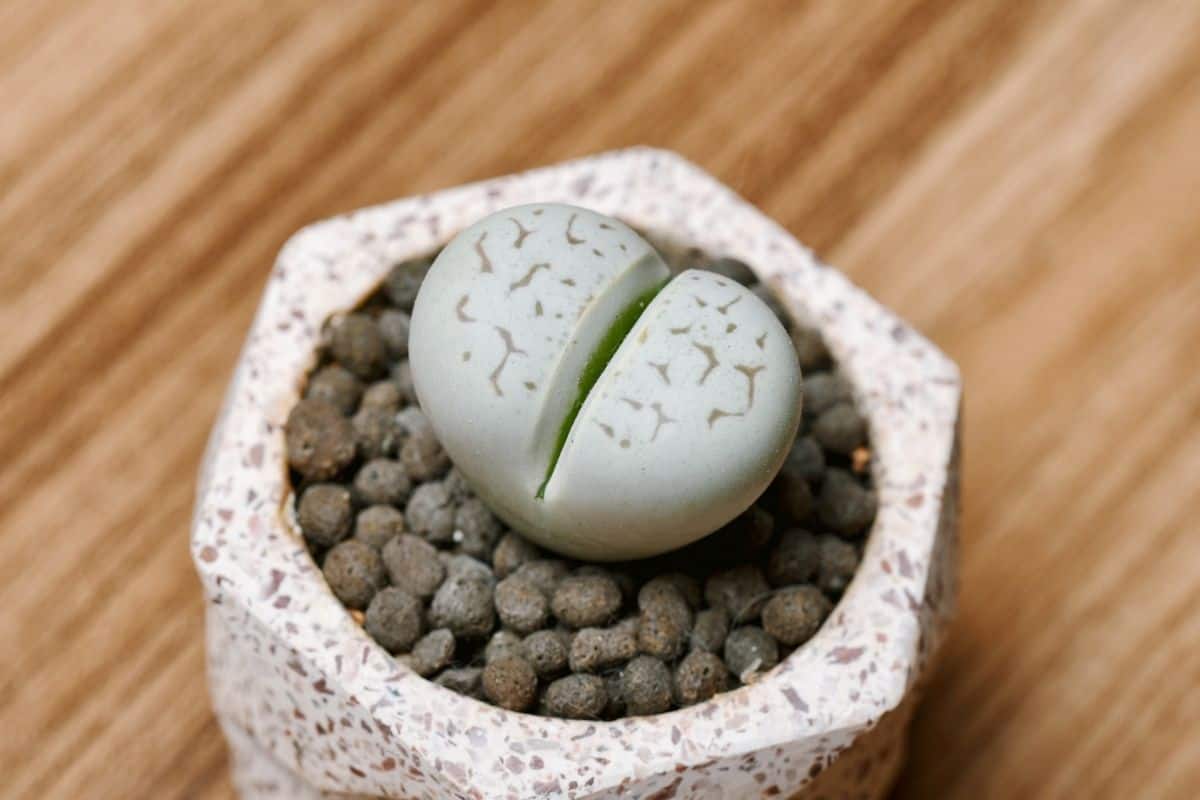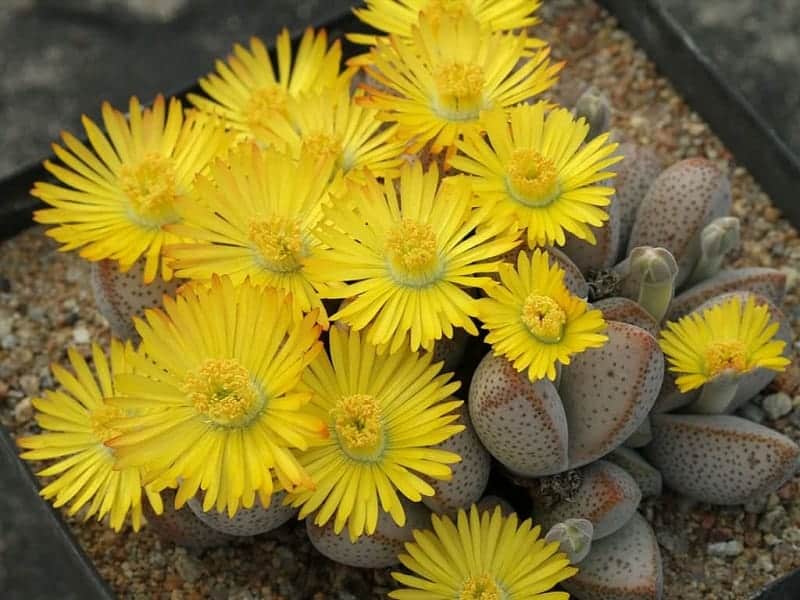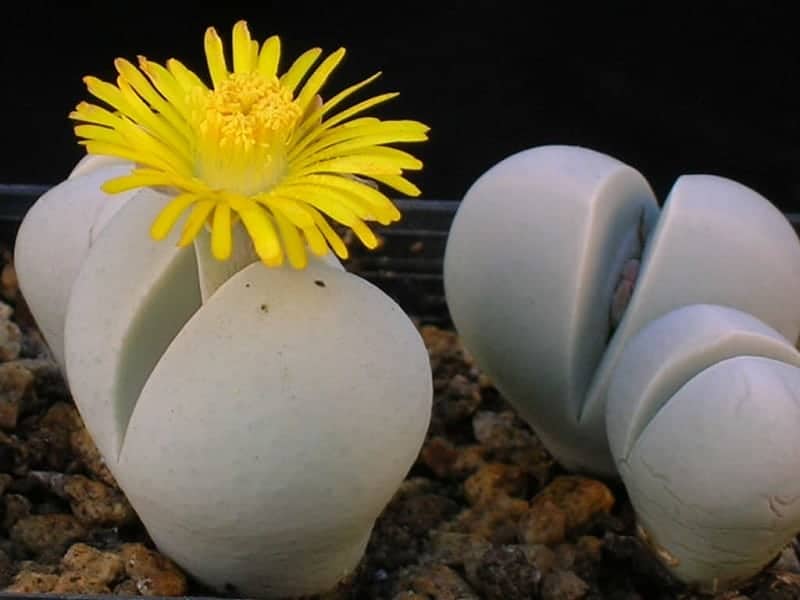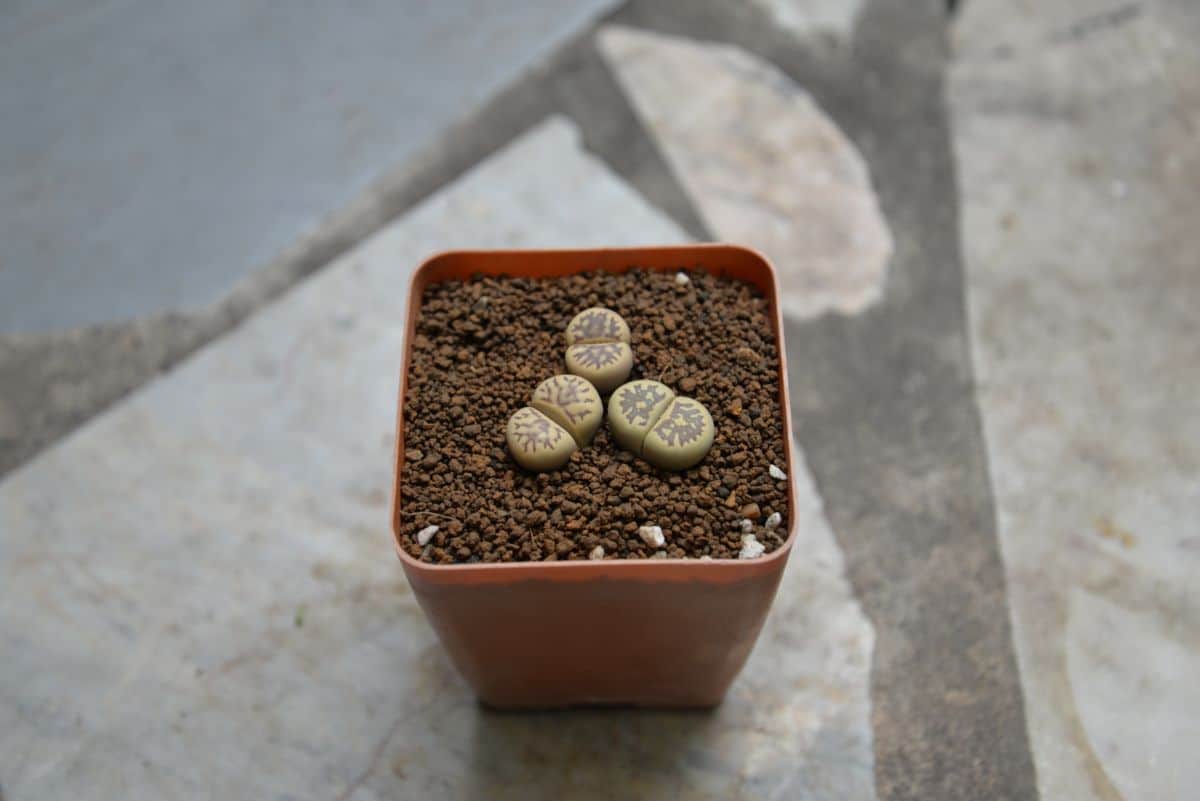Dinteranthus is a genus of stemless succulents native to southern Africa. These succulents are closely related to succulents in the Aizoaceae family, which includes the popular Lithops, as well as Lapidaria and Schwantesia.

However, unlike their relations, Dinteranthus require even less water and have a characteristic keel along their lower leaf surfaces.
Dinteranthus means “Dinter’s Flower”, as the plants are named for Professor Kurt Dinter, who earned the nickname the “Father of Botany of Namibia”. Professor Dinter was considered a pioneer in the discovery of stemless mesembs such as Dinteranthus.
Jump to:
Dinteranthus Appearance
| Name: | Dinteranthus |
| Soil: | Fast draining soil |
| Blooming: | March and April |
| Light: | Full light |
| Water: | When the soil is completely dry |
| Propagation: | Offsets, cutting and seeds |
Dinteranthus are known for their stone-like appearances. Though they vary in color, most are similar to the color of local rocks. They may be grey, greyish-green, or brown, sometimes with small flecks of color.
As previously mentioned, Dinteranthus is stemless with leaves that typically grow in pairs. The leaves are fleshy and may be boat-shaped or rounded. Depending on the species, the leaves may also have a velvety texture.

Buy it from:
Dinteranthus are petite succulents that typically stay under a few inches tall. The leaves are usually no more than about 1.6 inches in length.
Between the pairs is a deep cleft, which is where their flower is produced when in bloom. The solitary flowers are quite distinctive and are most often a vibrant yellow color, but they may also be white. They have many petals and may also have a hint of red at the tips of the petals.
The flowers are quite large and showy, which is why these succulents earned the name “Dinter’s Flower”. These succulents typically bloom in the fall.
After blooming, a pair of new leaves is developed as the old pair shrivels away. However, unlike Lithops, it’s not uncommon for Dinteranthus to have two active pairs of leaves at any given time.
Caring for Dinteranthus
If you’re familiar with caring for Lithops, caring for Dinteranthus will not be much different. However, it’s important to be aware that these plants require much less water than Lithops. Drainage is especially crucial with these plants, so be prepared to plant them in well-draining soil.
If you can get the care right, your Dinteranthus just might reward you with a beautiful flower once autumn arrives.
Water
If you’ve ever cared for Lithops, consider how frequently you water it and understand that the same watering schedule will be too much for Dinteranthus. These succulents absolutely thrive on neglect.
The vast majority of problems that gardeners have with this unique genus of succulents is caused by overwatering. It’s always best to err on the dry side, so if you have any doubts, don’t water your Dinteranthus.
Dinteranthus are prone to rot, so it’s crucial to get their watering schedule just right. During the coldest months of winter, this succulent should be watered very little, if at all.

When grown indoors, central heating can create a drier environment than Dinteranthus is used to, so you may need to water occasionally to prevent dehydration. You can also spray the plant with water if you’re hesitant to fully water.
Overwatering during the winter months will cause this plant to bloat and rot, so it’s important to keep it dry. During this time, the plant will use the nutrients and moisture contained in its leaves.
No products found.
You can resume normal watering in the spring, usually, March or April, once the outer leaves of Dinteranthus have shriveled up. At this time, the outer leaves will completely dry up and fall off and the plant will need an external source of moisture.
If you live in an area that’s particularly humid or are experiencing cool or wet weather, it’s important to reduce watering to prevent accidental overwatering. Likewise, you’ll need to adjust your watering schedule during, particularly hot and dry weather during the succulent’s active growing season.
As previously mentioned, Dinteranthus differs from Lithops in that it frequently has two pairs of actively growing leaves. If your Dinteranthus has more than two pairs of leaves, it’s a sign of overwatering.
To correct this problem, you’ll need to stop watering and allow the plant to absorb the moisture from the outermost pair of leaves. If you continue watering, Dinteranthus will eventually rot.
Light
When grown indoors, Dinteranthus requires as much light as you can provide. A south-facing window is ideal, but if your indoor space doesn’t provide enough light, you’ll need to use a grow light. This is not a succulent that can tolerate low light environments.
These sun-loving succulents require a lot of light to grow, so it’s important to be able to provide them with the right environment. Grow lights are a great way to do so regardless of where you keep your succulents indoors.
When choosing a quality to grow light, it’s recommended to opt for a full-spectrum light. Grow lights are available in a range of shapes and sizes to suit your indoor space.
When grown outdoors, Dinteranthus requires full sun. However, caution should be taken with seedlings that are less than a year old. Seedlings can be a bit more delicate and will not be able to tolerate a full day of direct sunlight.
Temperature

Dinteranthus are not frosted tolerant plants. If they are kept completely dry during the winter, they may be able to tolerate a light frost, but a hard freeze will certainly kill them. Remember, these plants are native to southern Africa, so they’re used to warmer temperatures.
If you plant on growing your DInteranthus outdoors and live in an area where temperatures frequently drop below freezing during the winter, you’ll need to plan on bringing your succulent indoors until spring.
When grown indoors, the temperature isn’t as much of a concern, as it’s likely consistent throughout the year. However, it’s best to keep your Dinteranthus away from areas that may be exposed to sudden temperature changes or drafts.
As far as heat goes, Dinteranthus are incredibly tolerant. It’s not uncommon for gardeners in the southwestern United States to keep their succulents outdoors even when temperatures reach 120 degrees Fahrenheit or more.
As long as Dinteranthus is being watered properly, it should be able to survive the hottest of summers. Again, this does not apply to seedlings under a year old as they have a lower tolerance level. Extreme heat combined with the direct sun may be too much for a young Dinteranthus.
Read Related Topic: 21 Best Low-Light Indoor Succulents - Dead-Easy to Grow Inside
Soil

Like all succulents, drainage is essential to growing healthy Dinteranthus. However, these succulents require a faster draining substrate than most. Water retaining ingredients such as clay should be avoided at all costs.
Some gardeners recommend a bit of peat moss in order to keep the soil acidic enough, but care should be taken to balance this out with enough grit to promote proper drainage and airflow.
Commercial cactus soil is a good start, but you’ll need to add more grit in order to create the ideal substrate for Dinteranthus. Adding coarse sand, gravel, perlite, or pumice will improve drainage.
Though it’s a common recommendation made by inexperienced gardeners, you should avoid lining the bottom of your pot with stones. This will create a perched water table, which will expose your succulents’ roots to more moisture, rather than allowing it to drain away.
Container
As with soil, your container should promote proper drainage. Those cute pots without drainage holes will need to be saved for a different plant, as Dinteranthus requires as much drainage as possible.
If your pot doesn’t have a drainage hole, you can easily drill one provided you have the correct tools for the job.
It’s usually recommended to grow Dinteranthus in a shallow container. These plants have surprisingly small root systems and don’t need much room to expand. Shallow dishes also promote faster drying of the soil.
Dinteranthus can be grown alone in a container or in clumps or clusters. This is a personal preference, so long as you can ensure that each plant in the container receives the right amount of water.
Terracotta is also recommended as it absorbs some water and can help prevent overwatering. Plastic and glazed ceramic pots do not absorb water, so you’ll need to be more careful if you plant your Dinteranthus in one of these.
Propagating Dinteranthus

Dinteranthus can be somewhat difficult to propagate, but it’s not impossible. There are several methods of propagation that can be used, but each has its own pros and cons.
Whether you grow Dinteranthus from offsets, cuttings, or seeds, will depend on your own situation as no method is any better than another.
Offsets
Offsets are the easiest method of propagation, as the parent plant has done a large portion of the work for you. You simply need to divide the offset from the mother plant and replant it in its own container.
However, Dinteranthus doesn’t produce offsets frequently, so if you want new plants in a hurry, you’ll need to use other methods.
To remove an offset, simply brush away the top layer of soil and gently separate the offset’s root system from the mother plant. This can be done with your fingers or a sharp, sterile knife.
Once separated, you’ll need to allow the offset time to air dry so as to prevent potential infection once introduced to new soil. Some gardeners recommend using sterile soil to further prevent infection.
Once dry, the offsets can be placed in their own container. Young offsets will need to be protected from direct sunlight until they’re mature enough to withstand harsher conditions.
See Related Article: Crassula Tetragona
Cuttings
Cuttings are not a popular method of propagation, but this is usually the method that’s chosen once the plant has grown quite long or tall. Most gardeners prefer a more compact look, so if this is the case, the plant can simply be beheaded.
Once you’ve beheaded your Dinteranthus, you’ll need to give it a few days to callous before placing it in its new container. Once calloused, it’s ready to be transplanted. Some gardeners dip the calloused end in rooting hormone powder to encourage faster rooting, but this step is optional.
After a few weeks, your Dinteranthus cutting should begin to produce tiny roots. At this point, you can care for it just as you would a mature plant.
Seeds
The most common method of Dinteranthus propagation is with seeds. Unfortunately, this is also the most time-consuming method, so you’ll need to be patient.
Dinteranthus seeds can be easily collected from the seed pods of your existing plants or they can be purchased from a reputable seed vendor. There are plenty of seed vendors online that can provide you with the seeds of your favorite Dinteranthus species.
It’s worth noting that Dinteranthus is a monocarpic succulent. Like Agave, these succulents die after blooming and producing a seed pod. This is the reason that they are commonly grown from seeds.
To grow Dinteranthus from seeds, sow the seeds in well-draining soil. It’s recommended to sow the seeds between late summer and late fall. The colder your climate gets during the winter, the earlier you should plant your seeds.
Most experienced Dinteranthus growers recommend using sterilized soil to help prevent problems with your seedlings or with germination.
They also suggest using an actual pot rather than a seed tray, as you likely won’t be transplanting your seedlings until they’ve survived their first year.
The seeds should be sprinkled across the surface of the soil, but they should not be covered or buried. Once the seeds are sown, the soil should be kept moist, and the container should be covered to help retain moisture.
Within a week or two, the seedlings should appear on the surface of the soil. They are incredibly tiny, so they may be difficult to notice at first. After the seedlings have sprouted, you can remove the cover.
The seedlings can only be exposed to direct sunlight for small amounts of time at first. This time should be built up over time so that by the time the first year is over, they should be ready to transplant and be grown in full sun.


